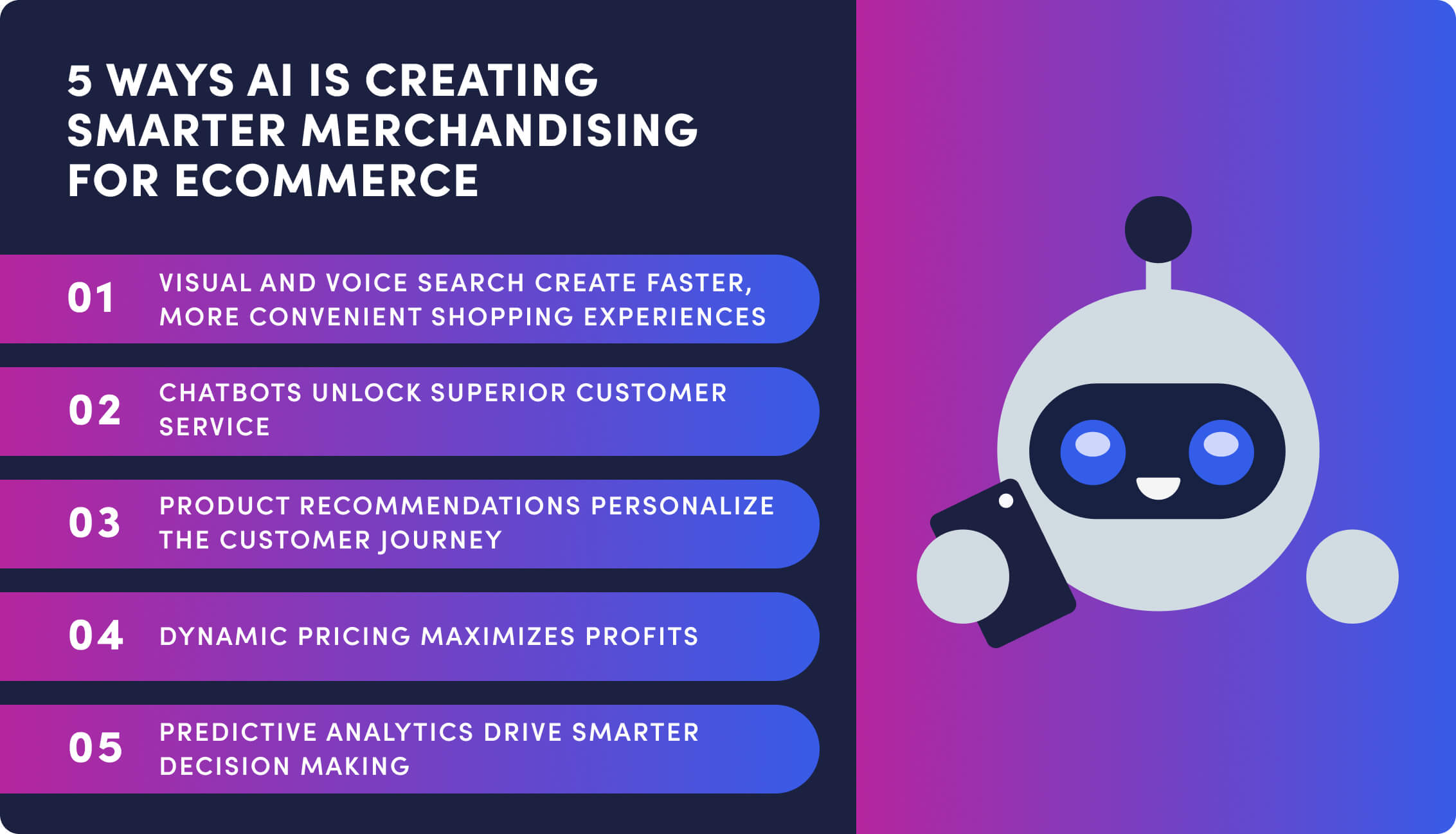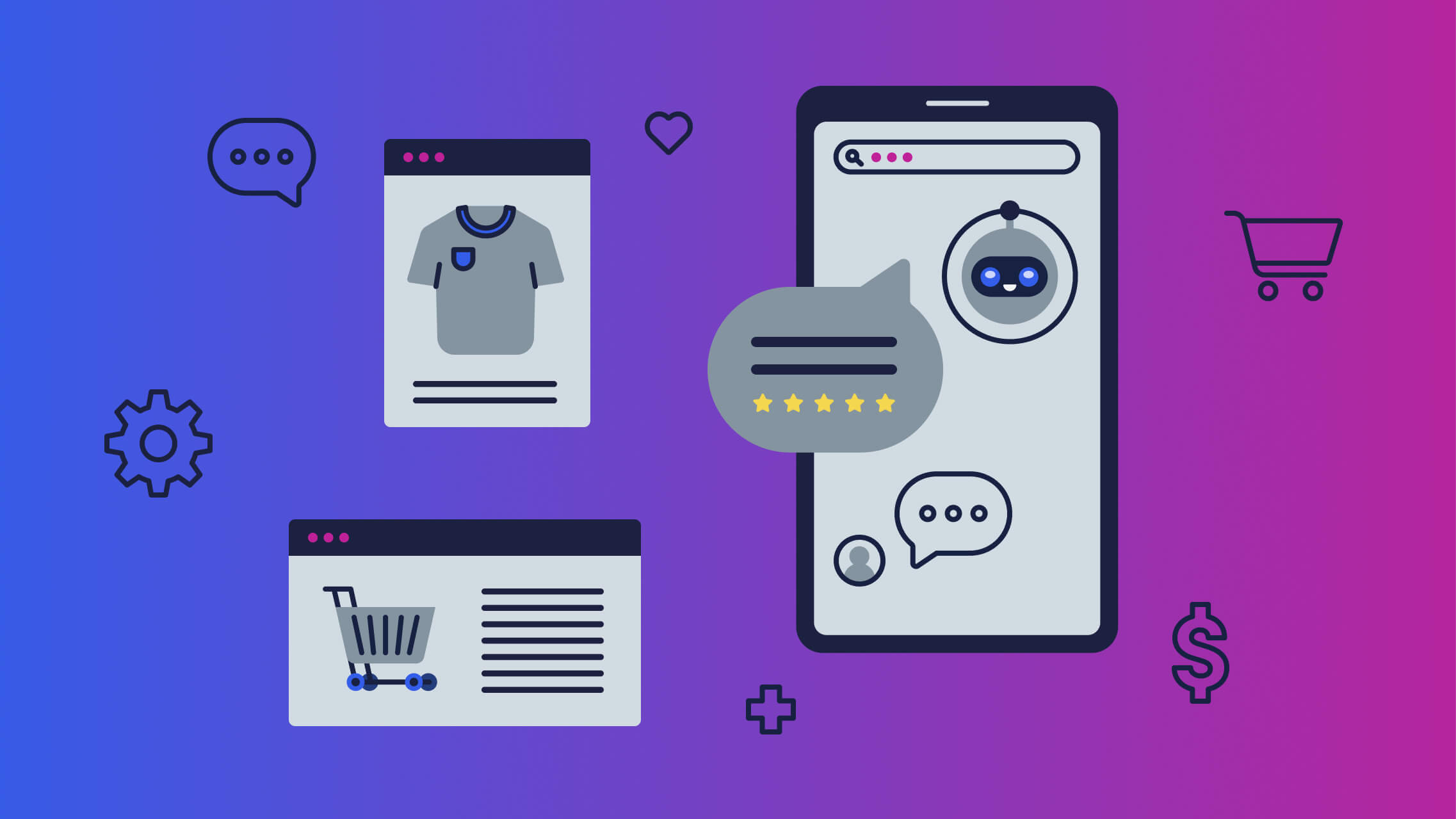In a hurry?
Here's the TLDR:
-
AI-driven advancements like visual and voice search, chatbots, and personalized product recommendations elevate the online shopping experience, boost customer service, and drive higher engagement, loyalty, and revenue.
-
Leveraging predictive analytics through historical data, market trends, and customer behavior empowers intelligent decision-making, enabling businesses to optimize inventory, pricing, and marketing strategies, leading to enhanced profitability, minimized waste, and heightened customer satisfaction.
Lately, it seems like everyone and their dog has been talking about Artificial Intelligence (AI).

You can't go on social media without seeing something about ChatGPT. And every other day there seems to be a new story about how bots are out to take our jobs.
Like it or not, though, AI is reshaping many industries across the globe, including ecommerce.
So if you must read one more article about AI, make it this one. You'll learn how AI-powered ecommerce enables smarter merchandising.
Spoiler: AI can help you drive profits, make better decisions, improve customer service, personalize the customer journey, and create a faster, more efficient online shopping experience.
Okay, commerce fanatics, let’s break down five ways AI is creating smarter merchandising for ecommerce.

1. Visual and Voice Search Create Faster, More Convenient Shopping Experiences
Your site visitors want convenience more than ever.
In fact, 56% say that retailers should make it easier to find options online. Visual and voice search technologies help customers find items on your site faster.
With visual search, customers can snap a picture or upload a photo of an item they want to buy. Then, AI image recognition technology will identify similar products in the store's inventory.
Voice search takes shopping experiences even further. It allows customers to look for products using voice commands. AI Voice assistants like Siri, Alexa, and Google Assistant can provide a seamless and hands-free shopping experience.
Half of the US population uses voice search features daily, and more young shoppers are trying out visual search. Therefore these two technologies give you an edge over competitors who rely on text-based search engines.
Actionable Tip💡
To help your ecommerce website rank higher for voice and visual search, optimize your product descriptions and metadata with natural language and relevant keywords. This will increase the chances of customers finding you using voice search. For visual search, make your website mobile-friendly with clear and high-quality product images.
2. Chatbots Unlock Superior Customer Service
Today's customers have high standards.
They expect seamless conversations across all channels. They also want follow-ups from support reps and proactive product recommendations. It may seem like customers are asking for a lot, which may have been the case 20 years ago. But now, with AI, you can meet these expectations and exceed them by deploying chatbots to automate your customer service.
Chatbots are great for customer service. That's because they provide instant assistance and are cost-effective, scalable, and consistent. They also collect valuable data on customer behavior, preferences, and pain points. These can be used to improve customer experience and inform business decisions.
For example, a chatbot on your site can help customers find items, suggest relevant products, and help with order tracking, returns, or refunds.
Actionable Tip💡
Regularly track chatbot interactions and use data analytics to track performance metrics. For example, average conversation length or goal completion rate. This ensures that your chatbot is delivering a high-quality customer experience.
3. Product Recommendations Personalize the Customer Journey
News flash: Consumers expect companies to understand their needs and wants.
And that's much easier to do when you're working with AI. With personalized product recommendations, you can deliver the right products at the right time that match your customer’s preferences and needs.
AI-product recommenders analyze customer data, like browsing, search, and purchase history. Then, they use machine learning to predict customer behavior and generate recommendations. This helps retailers provide personalized shopping experiences that increase engagement, loyalty, and revenue.
For example, you can use "best sellers" or "new arrivals" product recommendation strategies on the homepage or shopping cart. Or you can suggest "related" or "complementary products" to upsell customers higher-tier merch..png?width=2383&height=2110&name=6.%20In%20checkout%20recommendations%20(SHOPIFY%20+%20SPECIFIC).png)
Actionable Tip💡
Not all customers are the same.
Segment your audience based on their behavior, preferences, and purchase history. Then, deliver targeted recommendations based on these variables.
Group customers by similar characteristics and interests. This will help you provide personalized recommendations that better resonate with each customer. And that means you’re more likely to see higher conversion rates, more customer satisfaction, and bigger profits.
4. Dynamic Pricing Maximizes Profits
A dynamic pricing strategy helps ecommerce businesses maximize profits.
To match market demand and supply, you adjust prices in real time. It's like being a skilled surfer and catching the wave of consumer behavior at just the right time, riding it to shore like a champ.
Here’s how it works: AI analyzes various data points such as supply and demand, competitor pricing, and even the weather. Then, AI algorithms make pricing and merchandising decisions that maximize profits and sales. This is done with machine learning and statistical models.
For example, let’s say a store has a limited stock of a popular item. They can increase the price of that item to capture more revenue from customers willing to pay a premium. Or, if the store has a surplus of a less popular item, they can lower the price of that item to encourage sales and clear inventory. They can even offer special discounts to individual customers based on their shopping history.
According to Mckinsey, only a few online retailers use the competitive advantage of dynamic pricing. And surprisingly, in 2021, only 15% of ecommerce companies planned to use dynamic pricing, while 32% showed no interest in it. It’s a good time to pick up your surfboard and ride the wave of profit your competitors are missing.
Actionable Tip💡
Test different dynamic pricing strategies periodically for their impact on customer behavior and revenue. Doing this lets you identify which pricing models work best for your products and services. Look at different pricing tiers, discounts, and subscription models. Then choose the pricing strategy with the highest conversion rates and customer retention.
5. Predictive Analytics Drive Smarter Decision Making
Smarter merchandising leads to smarter business decision-making.
That’s where predictive analytics comes in. Predictive analytics looks at a combo of historical sales data, market trends, and customer behavior, to predict future sales and even demand for specific products.
Armed with this information, you can adjust your inventory levels, pricing, and marketing strategies. Over time you’ll increase revenue and streamline operations.
Suppose the predictive analytics forecast shows increased demand for a product next quarter. Your business can increase inventory, adjust pricing, touch up your visual merchandising, and launch targeted marketing campaigns. You’ll drive sales for that product and have the inventory to support the new demand you've generated.
That means improved profitability, reduced waste, and increased customer satisfaction.
Actionable Tip💡
Go big or go home doesn't apply to predictive analytics. Start small by identifying one or two key business metrics that you want to predict, such as customer lifetime value or product demand. Next, collect and analyze historical data related to these metrics. Then, use machine learning algorithms to develop predictive models and refine them over time using new data and feedback.
Use AI to Up Your Online Merchandising Game Today
As an ecommerce retailer, your advantage comes from a better understanding of your customers and their needs. With AI and machine learning, you have the ability to create smarter, personalized merchandising strategies.
And as smart merchandising continues to evolve, forward-thinking retailers will equip their online stores with innovative ecommerce merchandising tools made for modern commerce.
Interested in partnering with Rebuy? Let's do it.
To keep up with the latest trends, platform updates, and more, follow us on LinkedIn.
